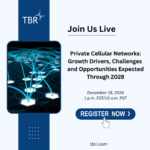Meet MAMAA: The Top 5 Hyperscalers Shaping the Future of Digital Ecosystems
What Are the Top 5 Hyperscalers?
Alphabet, Amazon, Apple, Meta Platforms and Microsoft are the five largest, most comprehensive hyperscalers in the world by a wide margin. This group of Tier 1 hyperscalers are collectively referred to as MAMAA.
TBR research shows only the Tier 1 hyperscalers can transcend most, if not all, of the major lifestyle categories to provide a seamless end-to-end ecosystem experience, touching all aspects of people’s lives, primarily due to their scale and access to resources.
An In-depth Discussion on How GenAI Will Impact the Telecom Industry — Watch Now!
The World’s Largest Hyperscalers Are Positioned to Win an Outsized Share of the New Opportunities Created in the Digital Era
Tier 1 hyperscalers have momentum as they pursue their end-to-end digital ecosystem goals. Key reasons why hyperscalers will succeed in their digital ecosystem endeavors include:
- Scale
- Network effect
- Proficiency at building and scaling platforms
- Adept at translating data into outcomes
- Near limitless financial resources
- Access to the best talent
- Have the best legal teams
- Control essential intellectual property and patents (e.g., devices, chipsets, AI/machine learning algorithms, Lidar)
- Tax advantaged — pay relatively little in taxes
Tier 1 Hyperscalers Intend to Own and Control Critical Aspects of the Value Chain in the Digital Era
The End Goal: Full-scope Digital Ecosystems
TBR believes the top 5 hyperscalers will own and control foundational and critical aspects of the digital economy and capture an outsized portion of the value created during the digital era.
- Societies will become dependent on their clouds.
- The majority of internet traffic will run over their networks.
- Transportation will be directed by their self-driving technologies.
- A significant portion of financial transactions will be processed via their payment platforms.
- And much, much more
If current trends play out, and assuming interference from regulators remains manageable, TBR believes MAMAA will ultimately become fully integrated, end-to-end digital ecosystem owners, providing essential solutions for businesses and consumers worldwide.
At a high level, hyperscalers are all pursuing the same strategy, which is to maximize the value of data. All of the Tier 1 hyperscalers are entering similar markets, introducing similar products and services, investing in similar technology areas, and pursuing similar business models. The underlying goal is to provide an immersive, seamless, end-to-end digital experience to end users (consumers and businesses), which will maximize hyperscalers’ value capture in the digital era. Value in its most basic form resides in the data that hyperscalers have access to, but leveraging that data to produce outcomes is how the hyperscalers make their money.
As Hyperscalers Redefine Digital Ecosystems, Industry Consolidation and Adaptation Become Essential for Long-Term Relevancy
As hyperscalers build out their ecosystems, some incumbent entities will become marginalized and fail, and the remaining incumbent players across industries will have to consolidate, adapt and/or partner with hyperscalers in some way or risk fading from relevancy. The markets for IT, advertising, retail, media, entertainment, financial services and other industries are already facing this disruption. TBR believes transportation, healthcare, education, telecom and other industries will also experience hyperscaler disruption during this decade.
The lifeblood of the digital era is data, and the heart is the systems, platforms, marketplaces and other digital infrastructure that make use of that data. Hyperscalers have thus far created the most compelling digital infrastructure that is capable of amassing, synthesizing, automating and utilizing vast amounts of data, which is the key underlying reason why they have been so successful in creating economic value over the past two decades.

 teekid, getty images via canva pro
teekid, getty images via canva pro
 Technology Business Research, Inc.
Technology Business Research, Inc.